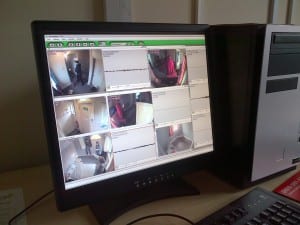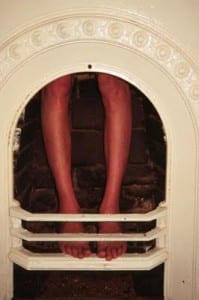
Home is “the place of one’s dwelling and nurturing, with its association” ((Little, W (1969) “The Oxford Universal Dictionary”, London: Oxford University Press.)). Entering the house, I got the complete opposite feeling to this definition of home. My first impressions were that the house was cold, damp, dirty and therefore a perfect performance space for a site specific performance.
From the reading, Pearson lists the differences between a performance on a stage and site specific. “At site, it is always as if for the first time” ((Pearson, Mike (2010) Site-Specific Performance, Basingstoke: Palgrave Macmillan. p17 )). Gaining the unique opportunity and experience to devise a piece from the house made everyone begin to have ideas for the final piece. Using the CCTV equipment installed in the house, the idea was said to prerecord some material and play it during the live performance causing juxtaposition. This could be used to a great extent as we could play with the audience and their reaction to the performance by filming it.
Learning how to use the CCTV system was very interesting to see the rooms from a different prospective . I found Govans Revisioning Place “ inhabiting space” interesting reflecting on the CCTV. “Making performance which deals with travel, context and orientation” ((Govan, Emma, et al (2007) Making a Performance, Devising Histories and Contemporary Practices Oxon and USA, Routledge p121)) From watching the groups in different rooms and how they adjusted to them to make a performance made me think of this as they all explored the rooms and what was in them. They also played a lot with props and explored the cupboards so they became more familiar with the space after their orientation.
When watching the groups, I was reflecting on how I could see everything in the rooms and what performance rehearsals were occurring. “From a different disciplinary standpoint” ((Pearson, Mike 2010, Site Specific Performance, Palgrave p23)) I had an inspirational idea from Eve Dent. Her work involves adjusting her body to where ever she decides to hides and only being able see her if you’re looking for her but to most people, she is invisible. This gave me the idea of the audience to explore and challenge them to find places to hide around the house. Some should be obvious that other but in some rooms like master bed room, there is a cupboard where you can fit at least two people and it would be interesting to see if they open the cupboard to find the performers. “Organic connection between art and the environment.” ((Govan, Emma, et al (2007) Making a Performance, Devising Histories and Contemporary Practices Oxon and USA, Routledge p133))


While I was watching the other groups on the CCTV, I had become familiar with listening in to their conversations. Making this productive we recorded it on the CCTV then writing down creating a script which we then went to that particular room and repeated it to them. This is the use of Verbatim. “The term verbatim refers to the origins of the text spoken in the play. The words of real people are recorded or transcribed be a dramatist during interview or research process…actors take on the characters of the real individuals whose words are being used.” ((Hammond, Will & Steward, Dan , 2008. Verbatim p9)) We tested and their reaction was just what we was looking for. This also links back to the reading and the Last Supper. “gives voice to the voiceless.” ((Govan, Emma. Nicholson, Helen & Normingtion, Katie 2007 Making a performance. Routledge p115)) As an audience member, one usually may think they are not allowed the speak during a performance and giving the the realisation that they have been watched. However, we had the idea of listening in to their conversation when none of the performers are in the room and repeating it to them when they least expect it.
“This sense of evoking the invisible is increased through a number of devices, including the director’s encouragement of ‘non-performing’, … Indeed, the whole status of the performers is ambiguous. Are the actors themselves? (they are named as such in the script.) Are they personas? Are they momentarily representations of the people whose words the speak?” ((Govan, Emma. Nicholson, Helen & Normingtion, Katie 2007 Making a performance. Routledge p115))